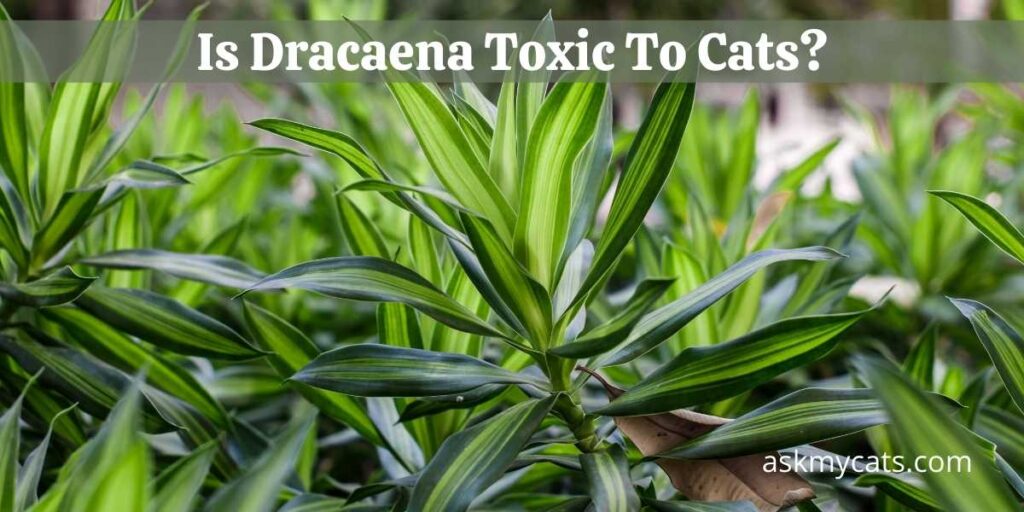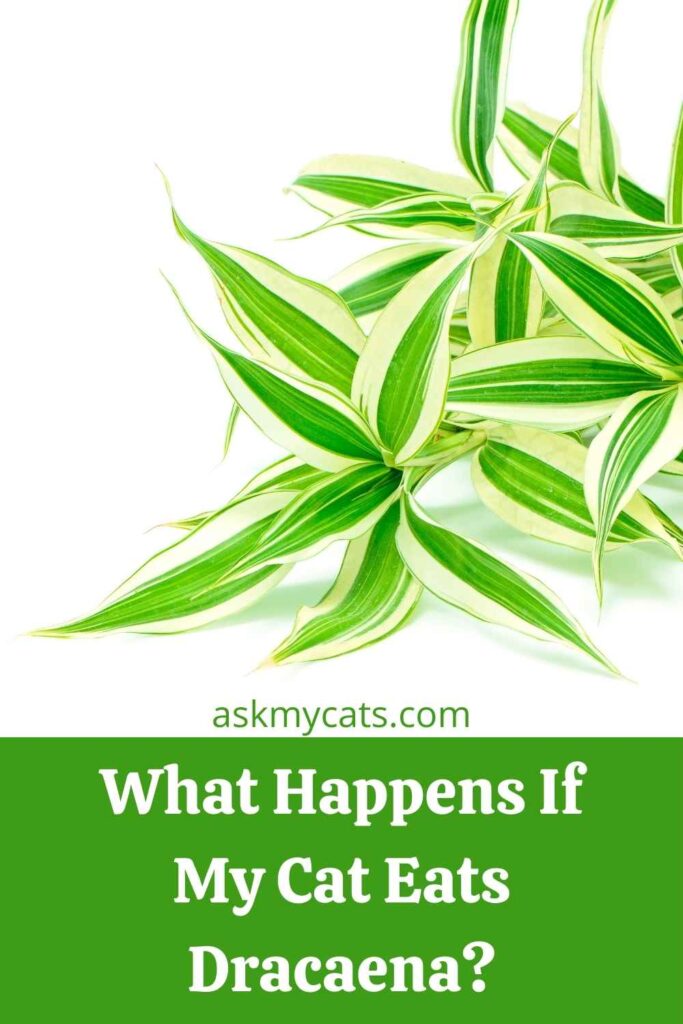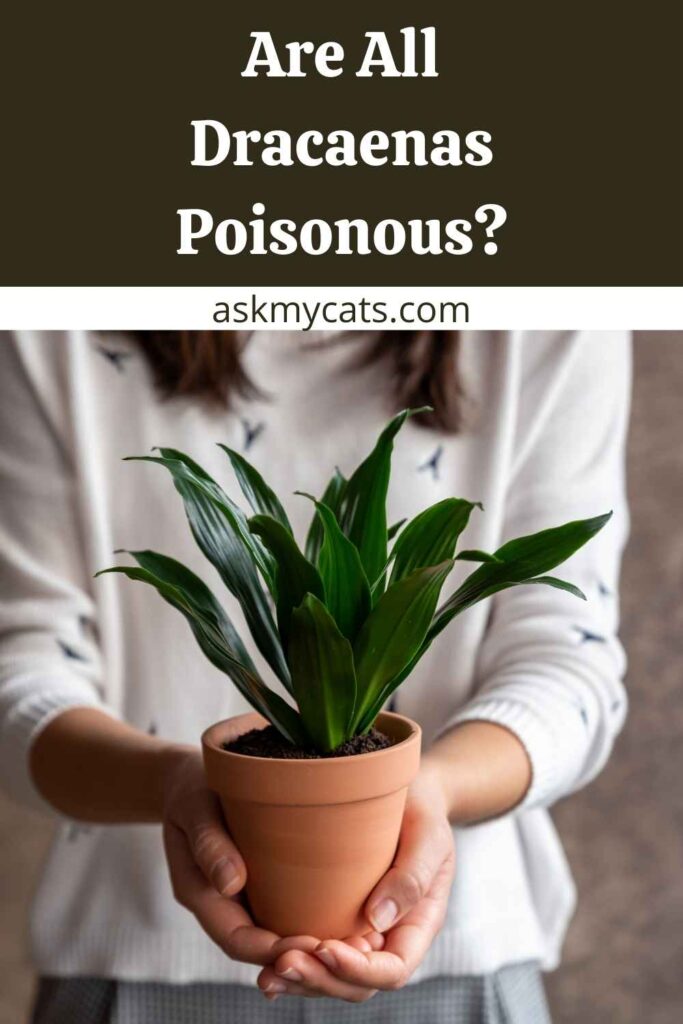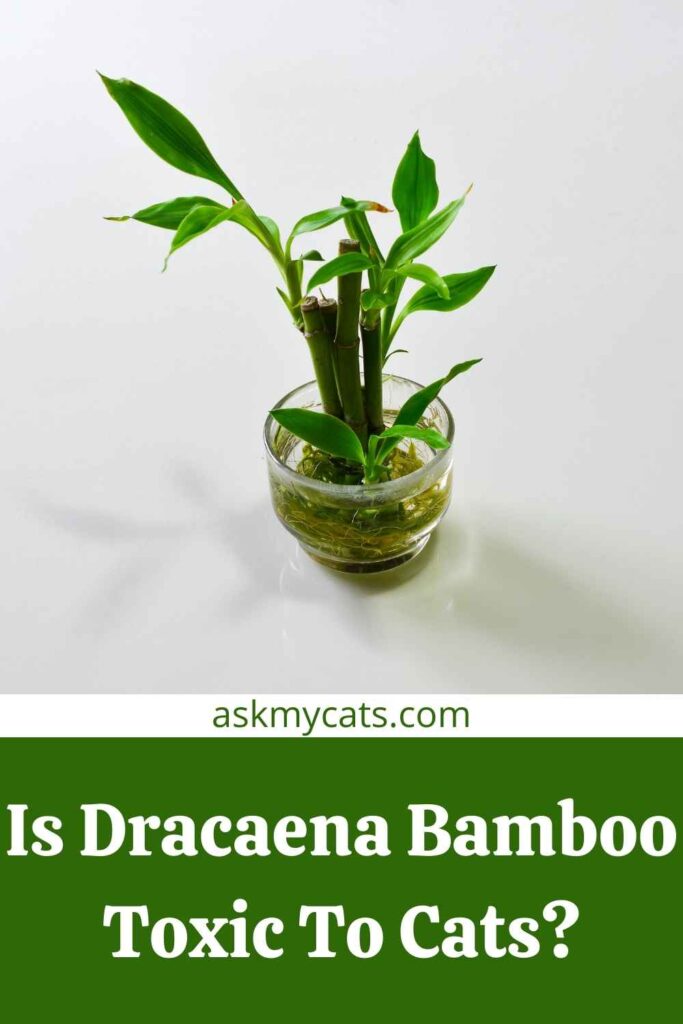Dracaena is a genus of plants that are popular as houseplants. On the other hand, our cats think we’ve set up a salad bar for them when we bring plants inside the home.
In a nutshell, Dracaena marginata is toxic and poisonous to cats. According to the ASPCA, the Dragon Tree possesses harmful qualities (saponin, a chemical component) that damage cats.
Since cats don’t always know what’s good for them, it’s crucial to realize how harmful they eat your plants. To understand more about dracaena toxicity in cats, continue reading.


Give Your Cat the Perfect Day
Get the Free Ebook!
What Happens If My Cat Eats Dracaena?
The most severe worry with dracaena toxicity in cats is the symptoms it causes. Vomiting, drooling excessively, and diarrhoea may all fast lead to severe dehydration, which can be a significant concern if not managed.

Fortunately, a veterinarian can readily treat it and get your cat back on its feet in a safe setting. It’s always better to be safe than sorry when it comes to your cat’s health.
Waiting it out when it comes to dracaena cat poisoning can be dangerous and even lethal.
If you’ve had a dracaena plant for a long time and your pet hasn’t shown any interest in it, it’s probably OK where it is.
If you’re having trouble, relocate it on a high shelf or a hanging basket where your cat won’t be able to reach it. A separate room for your cat is also a possibility.
The following are the symptoms of Dracaena toxicity in cats, according to the Cat Poison Helpline:
- Drooling
- Vomiting, sometimes with blood
- Diarrhea
- Abdominal pain
- Weakness or exhaustion
- Incoordination
- Dilated pupils in cats
An unusually rapid heartbeat is one of the additional symptoms mentioned. When large amounts of Dracaena are ingested, long-term consequences such as anorexia and depression have been documented.
Don’t panic; a trip to the veterinarian will assist your cat get rid of these symptoms as quickly as possible.
Are All Dracaenas Poisonous?
No, all dracaenas are not poisonous.

Before delving into the plant’s toxicity, keep in mind that the Dracaena family of plants is harmful to cats. You don’t want to make the mistake of believing you’ve found a non-toxic plant when you buy one of them.
Several distinct names know dracaena plants. Here’s a rundown of the most prevalent ones, along with instructions on how to spot them.
Corn plant, sometimes known as cornstalk plant, is a widespread Dracaena variety. The leaves are green, with a yellow line running through the middle.
The “Song of Jamaica” or “Song of India” is a variation that looks similar to the dragon tree but has broader green leaves. The margins are generally cream or golden in colour.
Small yellow stripes run down the edges of the “Janet Craig” variation. The “striped dracaena” resembles Janet Craig, except the margin lines are white rather than yellow. Finally, the “lucky bamboo” is a well-known dracaena plant with bamboo-like stalks.
Most plant enthusiasts choose these plants because they are easy to care for (which was one of the major pulls for me) and attractive. They can grow in various lighting conditions, making them appropriate for both indoor and outdoor use.
While all of this sounds wonderful, cat owners should consider that the Dracaena marginata is harmful to cats. Saponins are the poisonous property. It’s among many toxic substances that plants utilize to defend themselves against fungus and insects.
The chemical may be found in every section of the plant. The leaves, bark, stems, and roots are all included.
Is Dracaena Marginata Toxic For Cats?
Dracaena Marginata is toxic and harmful for cats.
Cats are naturally curious creatures that do anything they want during their nine lifetimes. It’s hard not to be fascinated by your houseplants, especially when they’re at home and bored by your absence.
Their curiosity may lead them to nibble on one of your houseplants, such as the poisonous Dragon Tree.
While the Dracaena is deadly to cats, they are unlikely to overeat since it is bitter. Furthermore, while the plant is only slightly to moderately poisonous, it will not kill you if you eat it.
To yet, no deaths have been linked to Dracaena plant-eating, according to the ASPCA. Even so, it’s preferable if they don’t consume it at all.
It isn’t easy to know if a cat has eaten the Dragon Tree because cats can’t communicate with us. Yes, you can tell when the leaves have been eaten, but it’s more challenging to detect when the whole plant has been chewed.
Fortunately, some indicators can alert you to your cat’s plant poisoning.
Is Dracaena Sanderiana Toxic For Cats?
Dracaena Sanderiana is toxic to cats.
According to the ASPCA, Dracaena sanderiana (lucky bamboo or ribbon plant) can be dangerous to cats. When consumed, it produces dilated pupils, stomach ache, increased heart rate, and drooling.
Ingesting lucky bamboo causes sadness, a lack of appetite, drooling, vomiting, incoordination, and frailty in cats. If you suspect your cat has consumed lucky bamboo, contact your veterinarian for advice on dealing with the poison.
Is Dracaena Bamboo Toxic To Cats?
Dracaena Bamboo or Lucky bamboo is poisonous to cats.

You want to keep your lucky bamboo plant out of reach at all times. To keep cats safe, another option is to make sure they are repulsed by it.
Lucky bamboo (Dracaena sanderiana) is more tropical water lily than bamboo.
A lucky bamboo may even be grown in a terrarium.
Indeed, we have little control over where our feline friends roam in our home. We can, however, ensure that cats do not get into touch with our lucky bamboo.
Before treating your cat for lucky bamboo poisoning, make sure they ate it.
Examine the plant closely to check if any leaves are missing, whether there are any bites or scratch marks, and so on.
It might take up to six to twelve hours for your cat to show signs or symptoms of ingesting the lucky bamboo, so if you believe they did but don’t have proof (the best evidence is to witness them eat it), wait before treating them and see if they display any signs or symptoms.
To see whether anything happens, wait at least 6 to 12 hours.
If your cat shows lucky bamboo poisoning, your veterinarian can attempt the procedures listed below.
Because vinegar has a strong odour, it’s a good choice. Vinegar is frequently utilized, even though it might damage the plant.
To keep your cats away from plants, try a range of household chemicals or scented products that your cat dislikes the smell of. It’s a simple and efficient method of keeping your cat safe. The more offensive the repellant, the better it will be.
Is Dracaena Warneckii Poisonous To Cats?
Dracaena Warneckii is poisonous to cats.
The Warneckii Dracaena (Dracaena deremensis ‘Warneckii’) is an evergreen-like plant that can grow into a tiny tree or a small decorative plant. Janet Craig plant and striped Dracaena are two more frequent names for this plant.
When consumed, saponins found in Dracaena species plants can induce drooling, vomiting, weakness, incoordination, and dilated pupils in cats.
Is Cornstalk Dracaena Safe For Cats?
Cornstalk Dracaena is not safe for cats.
Cats are poisoned by the corn plant, also known as the cornstalk plant, money tree, lucky bamboo, dragon tree, dracaena, and ribbon plant. If your cat eats a piece of cornstalk plant, it will have severe stomach discomfort.
While cats can become sick from eating maize plants, the toxin isn’t fatal. The poisoning and its symptoms can be resolved with immediate veterinarian care to remove any plant parts from the cat’s mouth and stomach.
After eating a cornstalk plant, your cat will be sick. If you notice it nibbling on a cornstalk or corn plant, take off pieces and place them in a plastic bag. Examine your cat’s mouth for any remaining plant stuff that it hasn’t ingested.
Cats’ eyes may get dilated if they consume a maize plant. The vet will give a more definitive diagnosis after looking at the plant samples you brought in. If your cat is still a kitten, one of the most common indicators of corn plant poisoning for your vet will be “drunk walking.”
Is Red Edged Dracaena Toxic To Cats?
Red-edged dracaena is toxic to cats.
According to the ASPCA, it is a popular houseplant harmful to cats. If eaten, the plant can cause vomiting (sometimes with blood), sadness, anorexia, hyper-salivation, and dilated pupils in cats.
Can Dracaena Kill Cats?
Yes, dracaena can kill cats since it’s too toxic.
Saponins are poisons that range from mild to moderate. As a result, unless your cat consumes an excessive amount of them, they are unlikely to harm her. Fortunately, because most of these plants are unpleasant, your kitty is unlikely to consume a large amount of them.
Depression, gastrointestinal pain, increased heart rate, incoordination, or wobbling in kittens is all possible signs, in addition to the ones we’ve already listed.
If you have proof that your cat has eaten dracaena, contact your veterinarian immediately. This can happen due to pica, boredom, or curiosity, especially in kittens.
How Do You Keep Cats Away From Dracaena?
You should keep the Dracaena plant out of your cat’s reach.
Keep all houseplants out of your cat’s reach and remove any fallen leaves regularly to avoid your cat from becoming ill from eating straight margined dracaena. Some people may decide to eliminate plants in their house that might harm cats.
Frequently Asked Questions
What Parts of Dracaena Plant are Toxic To Cats?
Saponin is a chemical substance found in the leaves of several plants. It belongs to a vast group of hazardous chemicals with comparable properties. Saponins may be found in various foods and plants, such as legumes and spinach, but they do not affect people.
What To Do If Your Cat Eats Dracaena?
If your cat eats your Dracaena, call your veterinarian right away. Your veterinarian can help you halt the response and manage the symptoms. Although the poisoning is severe, the symptoms it causes can lead to consequences. Diarrhoea, vomiting, or even drooling can all cause substantial dehydration in your cat.
Is Variegated Dracaena Toxic to Cats?
The dragon tree is another name for the variegated dracaena (Dracaena marginata “Variegata”). It’s one of several Dracaena-related garden and indoor plants hazardous to cats. Cats chewing on houseplants are one of the most regular emergency calls that veterinarians get.
Final Words
Dracaena is not a cat-safe plant, which is true of all species, variations, and cultivars. There aren’t any that are risk-free. If you notice any poisoning symptoms, see your veterinarian for a correct diagnosis and treatment. Any home remedies should be avoided.
Ask your questions in the comments section below.
